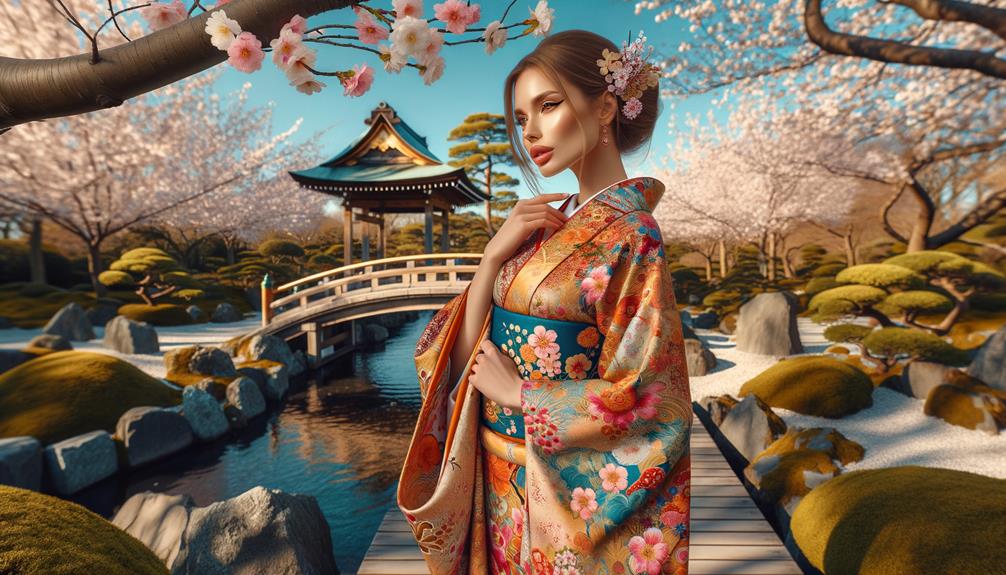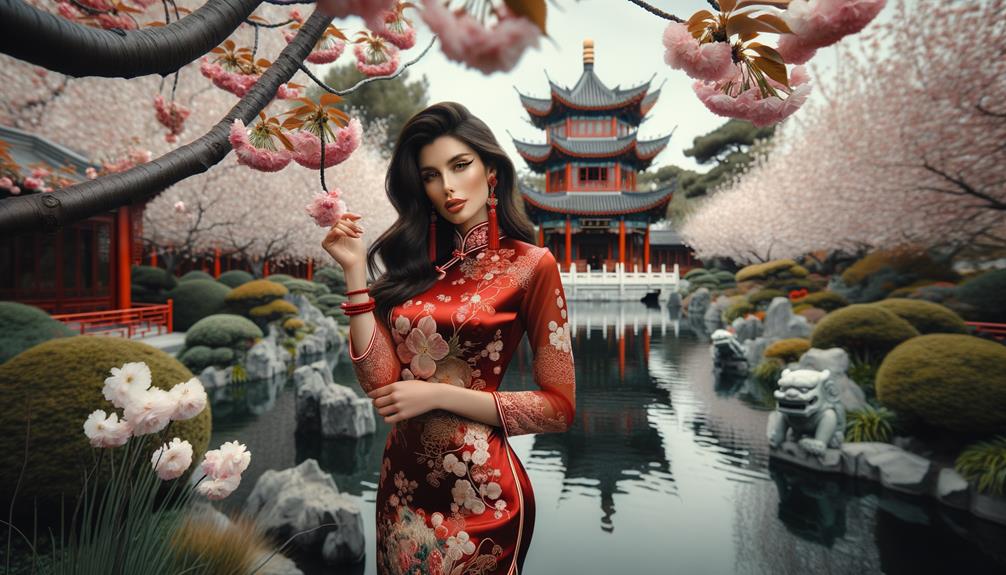I've always seen the Scottish kilt as a rich cultural symbol, intertwining centuries of history, identity, and pride. Emerging in the 17th century, it evolved from the fèile-breacan, featuring tartan patterns that tell stories of ancient clans. Each kilt carries the essence of its ancestors, resilient even through prohibitions and revivals. Accessories like the sporran and sgian dubh add depth to its narrative, while modern kilts blend age-old traditions with contemporary style. Whether at weddings or Highland Games, the kilt stands as a bold statement of belonging and elegance. There's more to uncover in its intricate folds.
Historical Origins
In 17th-century Scotland, the kilt emerged as a vibrant symbol of our heritage, woven from wool and tartan patterns. As I reflect on its evolution, I see the kilt not just as fabric, but as a representation of our identity, deeply rooted in our history. The shift from the long linen tunics and animal furs of the Léine era to the more refined tartan kilt marks a significant transformation in Scottish attire.
The kilt, knee-length and robust, originated from the fèile-breacan, a full-body garment that provided warmth and cultural significance. The accompanying plaid, draped over the left shoulder, added an extra layer of distinction and practicality. I imagine the Highlanders, clad in both kilt and plaid, moving through misty glens, their attire reflecting the rugged beauty of our homeland.
This traditional Scottish garb, both functional and symbolic, became more than just clothing. It was a badge of honor, a statement, and a connection to the land. Today, the kilt remains an integral part of Scottish identity, a timeless tradition that continues to inspire and define us.
Tartan Patterns
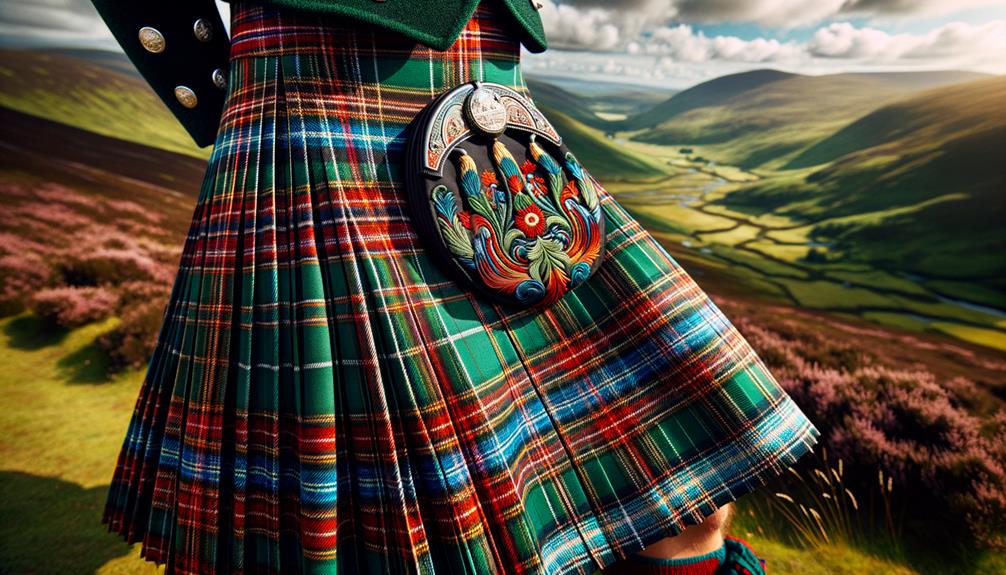
Tartan patterns weave a rich tapestry of intersecting colors, telling a story of ancestry and pride. Each stripe, each intersection, speaks to our Scottish heritage, transcending mere fabric to become a living symbol of tradition and kinship. With over 7,000 unique tartans recorded, these patterns are more than just designs – they bind families, clans, and organizations, fostering a sense of belonging and heritage.
In traditional Scottish great kilts, tartans were celebrated, each pattern a badge of honor. The history of tartan dates back to the 3rd or 4th century, enduring trials and tribulations, including a prohibition post-Culloden. Yet, it witnessed a grand revival in the mid-1800s, flourishing anew in high fashion, military uniforms, and as a symbol of unwavering identity.
Observing these tartan patterns, I marvel at their resilience and adaptability. They've endured through the ages, adapting to contemporary aesthetics while remaining rooted in our storied past. In every weave and weft, I see not just colors and lines, but the enduring spirit of Scotland.
Kilt Accessories
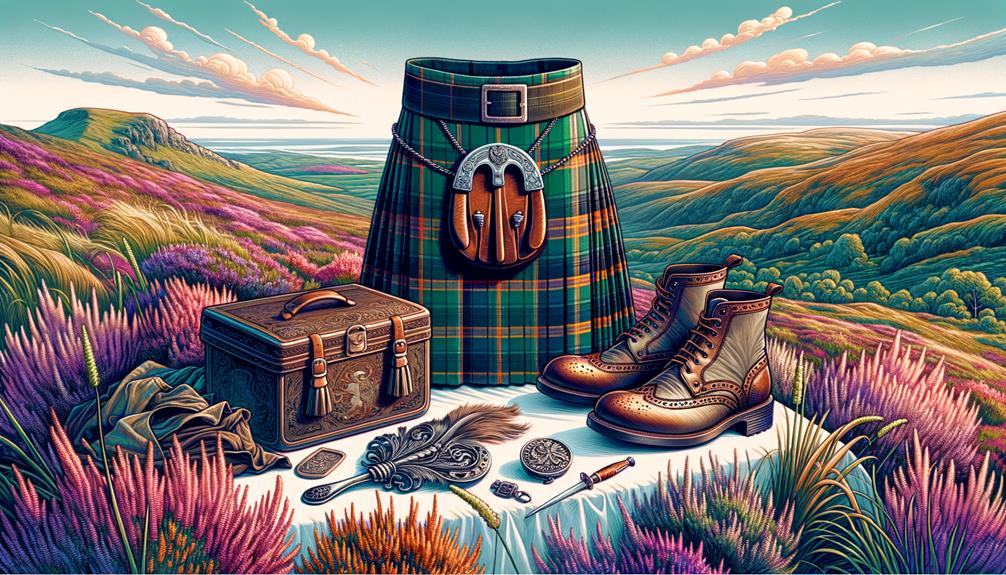
When I think of kilt accessories, I'm reminded of the intricate details that bring the outfit to life. The sporran, ghillie brogues, and sgian dubh each tell their own story, adding both form and function to the overall look. Flashes and plaid add a touch of elegance, making the attire not just traditional, but also timeless and sophisticated.
Essential Kilt Accessories
Every kilt tells a story, and its accessories – each with a rich history – complete the narrative. As I slip on my kilt, I can't help but admire how Sporrans, Ghillie brogues, Sgian dubh, and Flashes transform this simple garment into a tapestry of tradition and innovation.
The sporran, a decorative pouch, makes up for the kilt's lack of pockets. It swings with my every step, a symbol of practicality and charm. Ghillie brogues, with their unique laces and holes, were designed to navigate Scotland's wet terrains, yet they now tread modern streets effortlessly. The Sgian dubh, once a functional knife, now tucks into my kilt hose, a nod to history and a mark of elegance. Flashes, those colorful bands, secure my kilt hose, keeping them perfectly in place.
| Accessory | Purpose | Modern Significance |
|---|---|---|
| Sporran | Holds essentials | Decorative and practical |
| Ghillie brogues | Waterproof footwear | Traditional yet trendy |
| Sgian dubh | Historical knife | Decorative |
| Flashes | Holds up kilt hose | Adds flair and function |
These accessories don't just complete the outfit; they weave tales of heritage into every fiber, making each kilt a living, breathing expression of Scottish tradition.
Traditional Kilt Add-ons
Among the traditional kilt add-ons, each piece carries a hint of Scottish heritage and charm. The sporran, a humble yet essential pouch, takes center stage. In the absence of pockets in kilts, the sporran becomes a practical and heritage-rich repository. Its leather or fur exterior, adorned with intricate designs, showcases the craftsman's skill.
Ghillie brogues, with their distinctive holes and long laces, are more than just footwear – they're a testament to Scotland's rugged landscapes. Designed to let water escape, they strike a balance between form and function, blending resilience with elegance. As I lace them up, I imagine traversing misty moors and ancient glens.
Tucked into my kilt hose, the sgian dubh rests – a small dagger that was once essential for protection, now a symbol of honor and tradition. Its handle, often carved with Celtic motifs, feels like a connection to a warrior's spirit.
And then, there's the plaid. Draped over my shoulder, it's more than fabric; it's a tangible link to the great kilt, enveloping me in layers of history. Each accessory tells a story, weaving Scotland's storied past into the present.
Cultural Significance

Embracing the kilt is like wrapping myself in the very essence of Scottish heritage and pride. This highland dress, more than just fabric, weaves together threads of Scottish national identity and cultural significance. When I wear it, I feel the echoes of the Jacobite rebellion, the fierce battles, and the undying spirit of our ancestors.
The kilt is not just an article of clothing but a symbol of our history and traditions. It speaks volumes without saying a word. When I put it on, I'm reminded of three essential aspects:
- Historical Legacy: The kilt represents defiance and resilience from the Jacobite rebellion to World War II.
- Clan Identity: Each tartan pattern tells a story, a lineage, linking me to my roots and my clan.
- Cultural Pride: Wearing a kilt at formal events or daily routines reflects our enduring cultural significance.
I find the kilt's global recognition both humbling and inspiring. It's a vivid reminder that our small nation holds a rich tapestry of traditions worth preserving. As I wrap the kilt around me, I'm not just wearing cloth; I'm embracing a legacy that continues to inspire pride in our cultural heritage.
Modern Usage
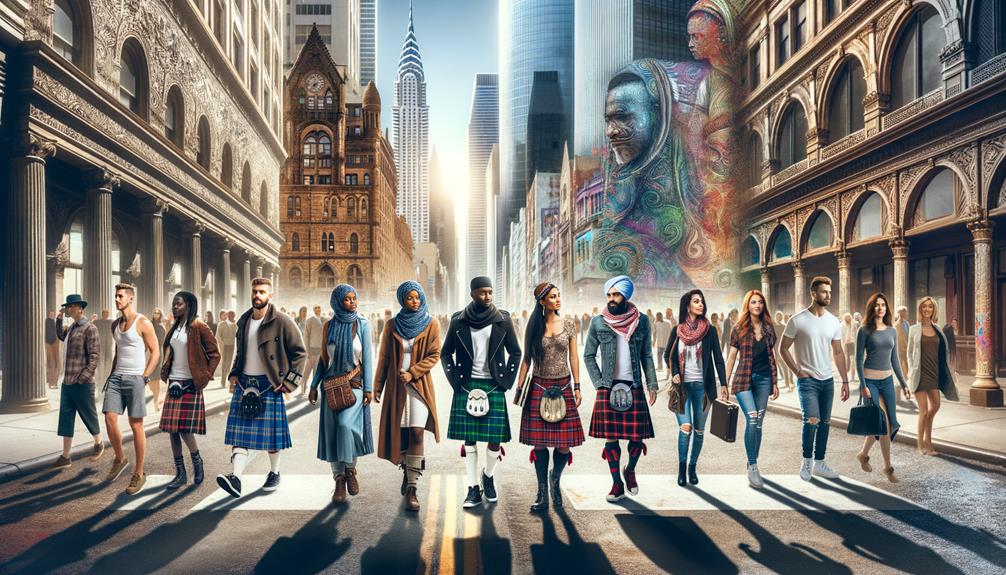
When I see kilts at weddings or festivals, I'm reminded that they're not just relics of the past, but a vibrant part of contemporary style. They seamlessly blend tradition with modern flair, turning heads and inspiring pride. Each kilt has a story to tell, weaving history into the fabric of today's cultural landscape.
Contemporary Fashion Trends
In today's fashion landscape, the kilt is more than just a relic of the past – it's a vibrant, evolving garment that seamlessly blends tradition and contemporary style. I've witnessed how the modern kilt effortlessly transitions between special occasions and everyday life, infusing its iconic Scottish essence into modern fashion.
- Weddings and Ceremonies: The kilt remains a staple, exuding elegance and heritage.
- Highland Games: It proudly stands as a symbol, worn by athletes as they compete, merging strength with tradition.
- Daily Wear: I've noticed kilts in urban settings, styled with modern twists that make them versatile and current.
These modern kilts transcend mere clothing; they are living affirmations to a culture that refuses to fade. They are not just for those tracing their Scottish roots but for anyone drawn to their unique blend of tradition and innovation. In every pleat and pattern, the kilt tells a story, one that continues to evolve, capturing the imagination of a world always hungry for the new.
Cultural Significance Today
Today's kilts, with their intricate patterns and rich history, are more than just garments; they're vibrant symbols of a living culture that continues to thrive in the modern world. As I observe these iconic pieces, I see more than wool and pleats. I see the threads of tradition woven into the fabric of Scottish culture, a blend of past and present. Whether worn at weddings, formal events, or by Scottish regiments in the British army, the kilt stands as a demonstration of enduring pride and identity.
In contemporary times, kilts have evolved, balancing tradition and innovation. Designs and lengths may vary, but the essence remains unchanged. Each kilt tells a story, a narrative of heritage and personal expression. Wearing one isn't just a nod to history; it's a bold statement of belonging and individuality.
For many, donning a kilt during ceremonies or special occasions isn't just about style – it's a profound connection to roots and a celebration of cultural legacy. This timeless garment, with its unmistakable flair, continues to be a distinguished symbol of Scottish pride, recognized and revered worldwide. The kilt, in all its splendor, remains a vibrant part of our global cultural tapestry.
Event and Festival Wear
The kilt, with its timeless charm and vibrant patterns, brings a touch of heritage to modern festivals and events. At weddings, Highland games, and cultural ceremonies, the kilt transforms into a living representation of history and pride. Each pleat and fold tells stories of the past, embracing today's spirit.
I've noticed how contemporary kilts adapt to modern tastes, offering variations in design and length. They've evolved while remaining quintessentially Scottish, showcasing our ingenuity. Whether it's a formal gathering or a casual celebration, the kilt's presence is undeniable, blending the past with the present seamlessly.
Here's where the kilt continues to shine:
- Weddings: The kilt adds a touch of regality and tradition, making every ceremony deeply connected to Scottish roots.
- Highland Games: A symbol of endurance and strength, the kilt is worn proudly by athletes showcasing their skills and heritage.
- Cultural Festivals: From parades to community events, the kilt stands as a symbol of identity and unity.
Observing how the kilt weaves through these events, I find a poetic balance between innovation and tradition, a rhythm that resonates deeply within us all.
Kilt Variations
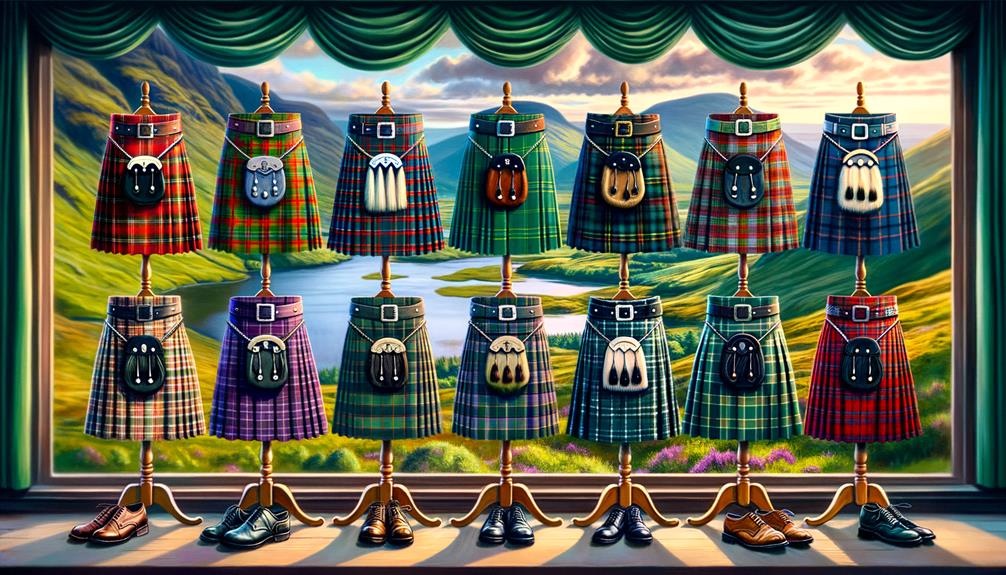
Exploring the diverse world of kilts, I find a range of styles that cater to different tastes and occasions. The great kilt, with its deep roots in the Scottish Highlands, exudes a sense of historical resilience, having once defied the constraints of the Dress Act. Each pleat and fold tells a story of battles fought and traditions preserved.
Casual kilt outfits, often paired with accessories like sporrans and kilt pins, exude a relaxed yet dignified aura. These are more than garments; they're expressions of individuality, customized to one's unique style preferences. With prices starting at $95, this Scottish icon is accessible to many.
On the other end of the spectrum, the Prince Charlie kilt outfits embody sophistication and elegance. Deluxe packages, which require 7-8 weeks for meticulous crafting, can reach up to $1,225. These ensembles, complete with Fly Plaid and high-quality materials, are investments in heritage and luxury.
Whether you opt for a casual, ready-to-wear kilt or a bespoke luxury ensemble, the kilt's variations offer a journey through time and tradition, woven into the fabric of history.
Frequently Asked Questions
What Does the Scottish Kilt Symbolize?
The Scottish kilt is a powerful symbol of heritage and national pride. It serves as a connection between the past and the present, weaving together threads of history with modern style. At its core, the kilt represents a strong sense of tradition and cultural identity.
What Is a Scottish Kilt Outfit Called?
A Scottish kilt outfit, often referred to as Highland Dress, is a unique blend of heritage and modern style. Each piece tells a story, making it both timeless and innovative.
Why Do Scottish Guys Wear Kilts?
Why do Scottish guys wear kilts? It's a way to connect with their heritage, a nod to their brave ancestors, and a proud display of their unique cultural identity.
What Do Scots Traditionally Wear Under Their Kilts?
Underneath the kilt, there's a personal touch. Some Scots opt for breeks for modesty, while others go regimental for a daring sense of freedom. Each step reflects a mix of tradition and personal style, a quiet celebration of comfort and individuality within ancient customs.



